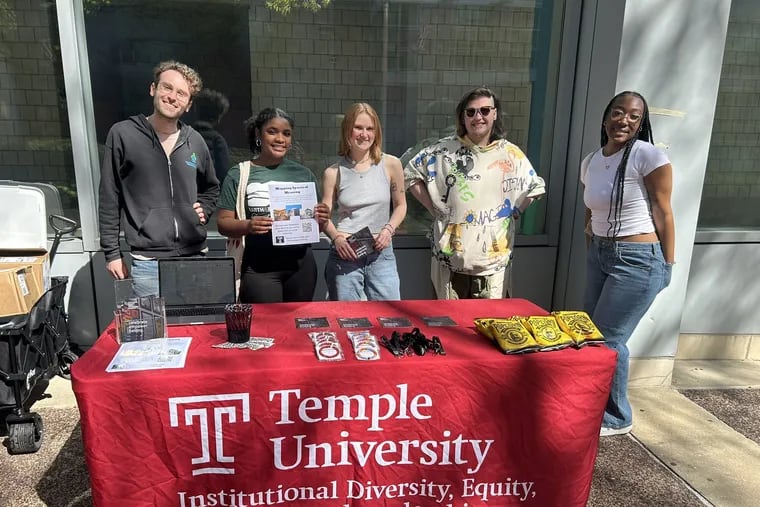On a walk near Temple’s campus, you might miss some of the neighborhood’s deep religious history and not notice all of the sites for present-day religious practice. Unless you had a map.
Temple University is developing a new resource to help its students, staff and other North Philadelphia community members explore the diverse religious practices of the Temple community. The project, “Mapping Spaces of Meaning,” will mark religious sites on an interactive digital map of Temple and its surrounding neighborhoods.
The map, which spans 22nd St. to Sixth St. west to east, and Glenwood Avenue to Spring Garden Street north to south, will also contain additional information about the sites, including pictures, videos and other resources that help explain a particular location’s religious and cultural significance.
An initial version of the map is expected to be available on Temple’s website at the start of the coming fall semester, and will be updated with information and other media about the sites as the project continues. The project is funded by a $5,000 grant from the nonprofit Interfaith America, which promotes religious diversity.
“Exploring the religious history of our city allows us to understand what our city is today and what we can strive to be,” said Ariella Werden-Greenfield, associate director of the Feinstein Center for American Jewish History at Temple University, and one of the faculty leaders of “Mapping Spaces of Meaning.”
“It really [allows] us to ask questions about the way that our students and our larger campus community are engaging with their religiosity, with the religious communities and institutions around them and those spaces that may be imbued with meaning on Temple’s campus,” she said of the project.
As David M. Kruger, the executive director of the Dialogue Institute at Temple University and the other faculty lead of the project, explained, North Philadelphia has rich religious diversity and history that can be overwhelming or go unnoticed without this kind of guide.
“There’s a long history [in] North Philadelphia of folks of German-Jewish descent, Ashkenazic Jews … during the Great Migration northward, there was a shift to more African Americans living in the neighborhood. Today, [there are] other immigrant communities living in the neighborhood,” he said.
Kruger also referenced the array of historic worship sites located in North Philly.
The most well known ones include Church of the Advocate, a National Historic Landmark that held the Black Panther Party convention in 1970; Congregation Rodeph Shalom, a historic synagogue whose Ashkenazic members established its congregation in 1795; and Makkah Masjid, formerly known as Mosque No. 12, here Malcolm X and the Nation of Islam once worshipped.
The project leaders said that their map will include more than these traditional religious sites. They aim to mark all places where people practice their religion or spirituality.
“You don’t necessarily know that on Fifth, near Temple’s campus, just a little bit north, we have a series of business that serve [Odisha Hindu] devotees,” Werden-Greenfield said.
The map will even include spaces where people go for peace and reflection, not specific to a particular religion.
“There’s all of these different religious communities that are utilizing spaces, even if they’re not marked as religious spaces, in order to connect with [each other], to connect with the divine, and to live lives that are filled with faith.”
Several Temple students have been working on “Mapping Spaces of Meaning,” first helping document sites through research, then working on outreach and surveying with other students to learn about other sites and their personal connections to those places.
Kruger’s Dialogue Institute also held training for these students on how to have better conversations with others about their religious differences.
“We can live in our own bubbles sometimes, and I think religion is a great way to connect people,” said Graysen Gill, 20.
Gill grew up attending an Episcopal church; she enjoyed the community there, but never felt particularly connected with her family’s denomination, or religion, for that matter. She joined the project to learn more about different religions and get more involved with the North Philly community, and believes that it has changed her perspective on religion and the city. Now, she appreciates the history and cultural significance of these religious sites much more than she did just walking by the buildings, unaware of their meaning.
“I want people to have introductory access to all of these different spaces in a fully comprehensive way because it can be kind of daunting to just do the research on your own and then have to figure out what sounds appealing to you,” she said.
Sidney Raine Jeffries, 19, similarly said that working on the map, talking to other students, and learning from the Dialogue Institute made her see religion in a new way.
“Religion and experiential practices are often a taboo or uncomfortable conversation for people to have. Going through these many workshops and talking within the team about our own upbringings, you realize it shouldn’t be a taboo … it’s something that is important to know … how to be religiously tolerant,” she said.
The project leaders understand that their work is particularly relevant at this moment, when college campuses have become centers of protest and conflict over the U.S. government’s support for Israel during the war in Gaza, which followed Hamas’ unprecedented attack on Israel in October, and campus safety concerns that have been expressed by students.
While resisting the idea that their map and calm discussion are solutions to that strife, Kruger said that he was greatly encouraged by what he has seen from the project’s students and their interactions with others. He says he feels that this generation is capable of finding ways to successfully navigate their ideological differences.
“You see so much in the headlines of students not listening to each other. … I found an incredibly amazing group of students who were deeply, intensely curious, wanting to approach conversations through a lens of dialogue and understanding. And I found that to be very, very hopeful,” he said.





